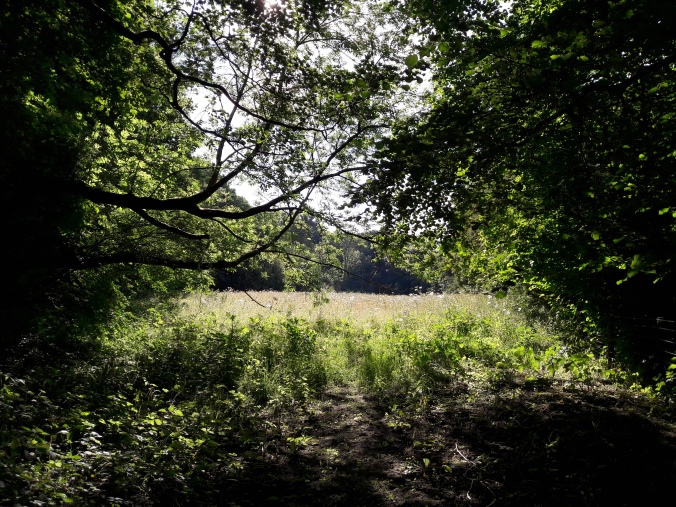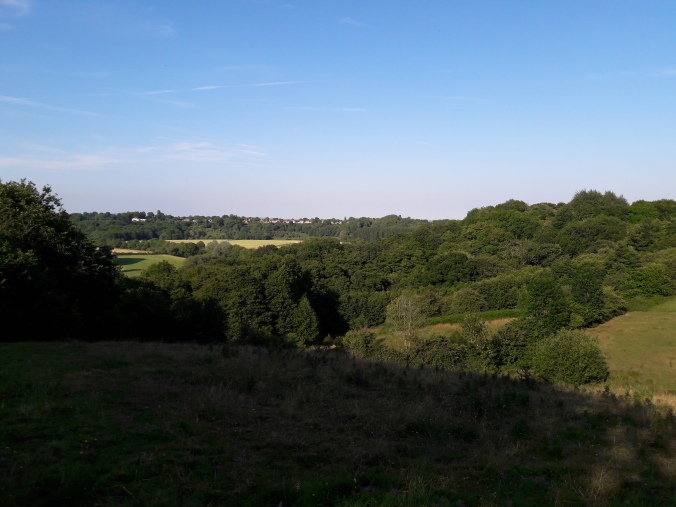Me and my boyfriend recently moved to a new village. One of the first things I do on entering a new place is look out for the small green signposts that indicate a footpath or bridalway. For me it’s an automatic thing, and I do it everywhere, even in places we’re only driving through on a way to somewhere else. ‘Looks like they’ve got good footpaths round here’, is a pretty common thing for people to hear me say. The truth is footpaths are like treasure hunts, leading to unknown parts of a world you thought you were already familiar with. Some are truly ancient, being walked for hundreds or even thousands of years, as the easies or safest routes between resources and settlements. Today some form continuous chains across miles of countryside, with signposts telling us this small section is part of a bigger plan, such as the McMillan way or the Nene way. Some are famous, walked by thousands each year, whilst some are so nearly forgotten that they might soon fade into the landscape, overgrown and uncared for. Since the act of enclosure footpaths have been a lifeline into the countryside, allowing a way through, or over, all those great hedges and barbwire fences. They give us a chance to go where cars don’t, where old chapels lie in ruin, where birds sing and insects buzz. They are immensely important, yet often we don’t even notice they are there.
So it is that myself and my boyfriend like to find and explore footpaths. No matter how overgrown, how poorly maintained. Our worst was a footpath which ended in a thick, thorny hedge, planted across the track so our only choice was to vault the fence. We refound the path though, and it was a beautiful walk. In our new village we had already found and explored many of the more obvious paths, well trodden by dog walkers. Yet one path seemed already to have vanished.

On the map the path is very clear, coming down from our village and then splitting in two, one path heading north and one south. In reality, whilst the northern path is clear the southern fails to exist, ears of corn standing guard where a path should be. High grasses lean in from the edge, covering any gap, whilst willows and alders line the bank of the river, their roots grown over with wildflowers and nettles. If any persons were to start suspecting a path existed here one of the trees has shed a branch across the way, meaning walkers must duck and dive below it to pass on. Yet we’re the stubborn sort so we thought we’d give it a go all the same.
Walking along the edge of the field was tough going, the ground uneven and the long stems of the grasses scratching at our bare calves as we went. The shade of the trees was pleasant though, on a sweltering hot day, and the babbling of the river sounded like a mermaid’s song to a sailor. It was only as we reached the edge of the vast field that the path reappeared. A bridge across a brook welcomed us with colourful disks denoting our way lay ahead and behind, taking us into the cool shade of a woodland. It slanted down to the river and up to the hill above. Here the path finally became clear, with even wooden boards installed to take us across the damp flushes which ran down the woods, throwing up pendulous sedges, Jurassic looking horsetails and clumps of bright green mosses.

We followed the woodland path, looking somewhat mystic with the bright sunlight breaking through the canopy. We caught glimpses of the clear calm river beside us, still looking tempting. Then we saw an opening appearing in the trees. Like stepping into a secret garden we entered into the glade and found ourselves surrounded by bright flowers, crowded high and dense across the meadow. The tallest were of course the large white umbrellas of the hogweeds, whilst below the yellow bird’s foot trefoil curled and the pink pyramids of common spotted orchids stood almost hidden by the long dry grasses. Orange and brown meadow brown butterflies flitted through the stems, busy in their task. A large green southern hawker dragonfly patrolled overhead, making its way across the meadow to a small pond surrounded by yellow flowers. These flowers are known as monkey flowers and are an invasive non-native species. I can’t deny how pretty they are but still a slight cause for concern amongst our beautiful native wildflowers.

It was hard to leave the meadow and step back into the shade of the woodland. Bathed in sunshine, surrounded by the dense trees, it seemed like a completely different world, like the fairies had stolen us away for the moment. But still we wound our way on.

Now the river came closer and across it we could hear laughter. A pub, an ancient sandstone building with benches against the bank of the river, beckoned to us. Unfortunately the river stood in the way. We’ve visited this establishment before, enjoying our drinks whilst gazing across the water. Once a boat took drinkers across from the very path on which we stood. What I wouldn’t pay for someone to bring it back.

We headed up and away from the river, through the trees and back out into the open. This time it wasn’t a dense meadow that greeted us but a grazing field, dotted with large ancient oaks. Still the grazing was clearly sympathetic with the wildflowers which grew here, with red clover, buttercups and the occasional orchid growing low to the ground. From here we headed back into the trees, taking up the path again, now overgrown with brambles, nettles and more monkey flowers. Rising high above the trees the path narrowed and I understood why some people might be reluctant to use it, one wrong step potentially leaving you tumbling into the trees below. We exited finally on a track leading to a large manor, who the woodland no doubt belonged to. I found myself wondering if the monkey flowers, the Japanese knotweed and other invasive we had seen along the way, originated from ornamental planting by the great house. A common mistake of ‘beautifying’ the wild causing long-term ecological consequences.

Our walk had one more surprise in store for us. We left the track to head down through hilly grassland fields, the woodland spread below, and our village perched atop the opposite hill. As we made our way down the hill we watched as the pink cones of orchids sprang up at our feet, first one, then two, then ten, then hundreds. A sea of pink lay spread out before us, delicate and beautiful.
That was the end of our footpath adventure, the trail leading us back through our woodland and then into the field of corn and home. We had had no idea where our feet would lead us that day, and no idea at all that such beautiful meadows existed such a short walk from our house. Not in a nature reserve, not in a park, but in the general countryside, where they belong. Perhaps if no one continues to walk this path it may one day disappear. It would be sad indeed for no one else to have the pleasure of discovering these meadows for the first time. After all this path has been walked for over a hundred years, by thirsty drinkers looking to reach the local pub. It would be a shame if my generation were the last one to enjoy this route, or indeed any of the other hundreds of thousands footpaths across the country. They are a lifeline to nature, to our countryside, it’s history and its present workings. And all we have to do it keep it working is find a path and walk.


We are badger sett surveying at the moment and so methodically following all the footpaths in the area grid by grid. Some are very well maintained and marked, while others are overgrown and misleading. Some don’t seem to exist anymore at all.
I can connect with your footpath adventure
Alex
LikeLike
Hi Alex
Great you’re getting out and about on the less used footpaths during your surveys. I love exploring overgrown footpaths but it’s a shame that it will stop a lot of people from enjoying them. Hopefully you might trample down the vegetation enough to encourage other people to explore.
Katie
LikeLiked by 1 person